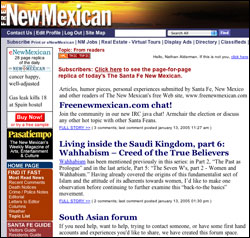By Nathan Alderman, J-Lab Online Editor
One of the oldest newspapers west of the Mississippi is home to some of the newest ideas in community journalism.
 The 155-year-old Santa Fe New Mexican is trying to collapse the gap between readers and reporters by allowing readers to attach blog-style comments to all the news stories posted on its FreeNewMexican.com site. Instead of writing a letter to the editor or logging into a separate online forum, readers can share opinions, corrections and suggestions on the same page as the article itself.
The 155-year-old Santa Fe New Mexican is trying to collapse the gap between readers and reporters by allowing readers to attach blog-style comments to all the news stories posted on its FreeNewMexican.com site. Instead of writing a letter to the editor or logging into a separate online forum, readers can share opinions, corrections and suggestions on the same page as the article itself.
FreeNewMexican.com is also one of the first sites in the United States to let user comments determine the order and placement of stories on its home page. “It’s a direct way of letting the public decide what’s important,” said online editor Stefan Dill.
“It was clear to me from the start that [the comments] offered a valuable chunk of openness to democracy,” said reader Ed Campbell, 67, who has become a regular site commentator. He asserts that the spectrum of political views expressed at FreeNewMexican.com is now “more rational and founded in fact than the pages of the print edition.”
The increased interactivity is paying dividends for the New Mexican in print and online. Since FreeNewMexican.com added comments to its articles in October 2004, newspaper subscriptions have increased by one percent, said Web publisher Michael Odza. Though monthly site visitors have remained between 100,000 and 150,000, “what’s really exploded is the depth to which visitors explore the site,” Odza said. In December 2003, visitors viewed a total of 750,000 pages. By December 2004, monthly page views numbered more than 5 million.
Reader comments are also encouraging reporters and editors to cover the news more thoroughly and suggesting new angles for follow-up stories, Dill said. A Jan. 31, 2005 story about the sentencing of a child molester prompted readers to share their own stories of surviving abuse and air their concerns about the state’s Children, Youth & Families Department. Readers’ comments prompted the paper to launch a follow-up investigation into the CYFD’s efforts to protect children. This cycle of feedback “generates better reporters, better news and happier readers,” Dill said.
The New Mexican runs two separate Web sites. One is for paying customers. Called eNewMexican.com, it gives subscribers a page-by-page replica of each day’s printed paper. The other, the no-cost FreeNewMexican.com, combines editors’ selections of daily local articles with wire copy and local columnists.
Dill and Odza introduced FreeNewMexican’s new interactive features in a bid to convince the family-owned paper that the free site could be a valuable resource. “It has allowed us to have some flexibility to experiment with different ideas since we’re not bound to the print content,” Odza said.
In addition to interactive comments, those ideas include a page that automatically tallies the site’s most-read stories in order of popularity; stories written by the paper’s readers, including a series on life in Saudi Arabia; online galleries of user-submitted photos; and a separate but related blog written by staff members such as state government reporter Steve Terrell.
Terrell, a New Mexican reporter since 1987, began supplementing his printed coverage of the state legislature with regular weekday blog entries in January 2005. “I thought it would be a fresh feature,” Terrell said, “and perhaps even attract some new readers.”
While stories for the printed paper are his top priority, Terrell said his blog allows him to get stories to the public more quickly and do so with more personality and humor. “You can use items that didn’t fit into the regular paper due to space,” Terrell said, citing his story about a play performed at the state capitol that parodied New Mexico Gov. Bill Richardson. “Also, I can post old stories I’ve written that might shed light on a current issue in the legislature.”
“The freedom is wonderful,” Terrell said. “On the other hand, you’re working without a [safety] net.” Blog entries can be edited after the fact, but the speed of blogging means that many are initially posted online without an editor’s approval. “There is a reason for editors, after all,” Terrell said.
Dill and Odza proofread and approve every user comment before it appears on the site. “It’s standard forum policing,” Dill said. “You have to watch for language, you have to control potential flame wars (heated exchanges of criticism) or trolls (people who post negative or offensive comments just to get attention) [and] keep discussions focused and on topic.”
Under Dill and Odza’s rules, readers must register to post comments. Rather than using anonymous screen names, their remarks appear under their full names. These restrictions help keep readers well behaved, Dill said.
As of January 2005, FreeNewMexican.com counted 45,000 registered users, Odza said. Of those, 2,000 had posted comments; the top 15 percent of all posters contributed 80 percent of the site’s comments.
FreeNewMexican has a variety of revenue streams. Funds from the print edition’s classified ads and the pay site’s subscription fees help to pay for FreeNewMexican’s operations. But the free site also offers online-only classifieds, directory listings and banner ads. It provides virtual tours for local Realtors, runs Google’s keyword-based text ads and sweetens classified ads from the print edition by adding photos or animated graphics.
In 2005, Odza hopes to expand these services to include do-it-yourself classified advertising and sales of New Mexican photos.
Campbell hopes that the site will supplement its story comments with more traditional online forums. “I think many of those who comment would welcome the opportunity to have a longer, deeper dialogue about the issues,” he said.
Dill said “the door’s wide open” for adding to the site’s interactivity. Current plans include RSS feeds to send new stories directly to readers, making the site readable on cell phones and other wireless devices, and more user-written articles. But he believes that participatory journalism is more than reader submissions. “[It's] about giving people a voice,” Dill said, “but you have to listen to that voice. You have to watch what your community does with the tools you offer and go with what they’re most comfortable using and doing.”



